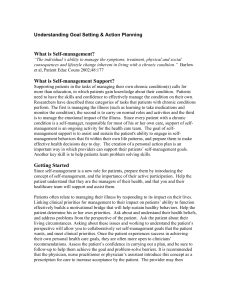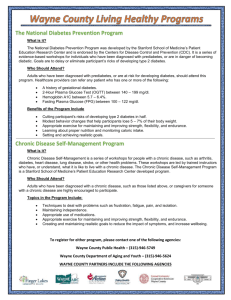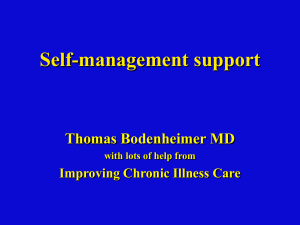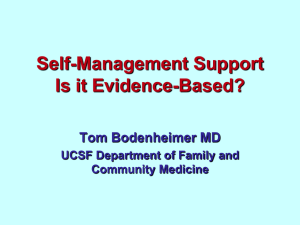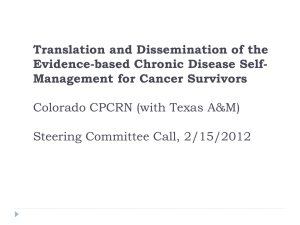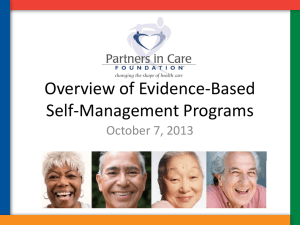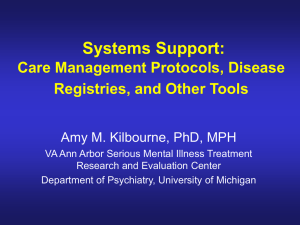Chronic Care Model Change Concepts and Package
advertisement
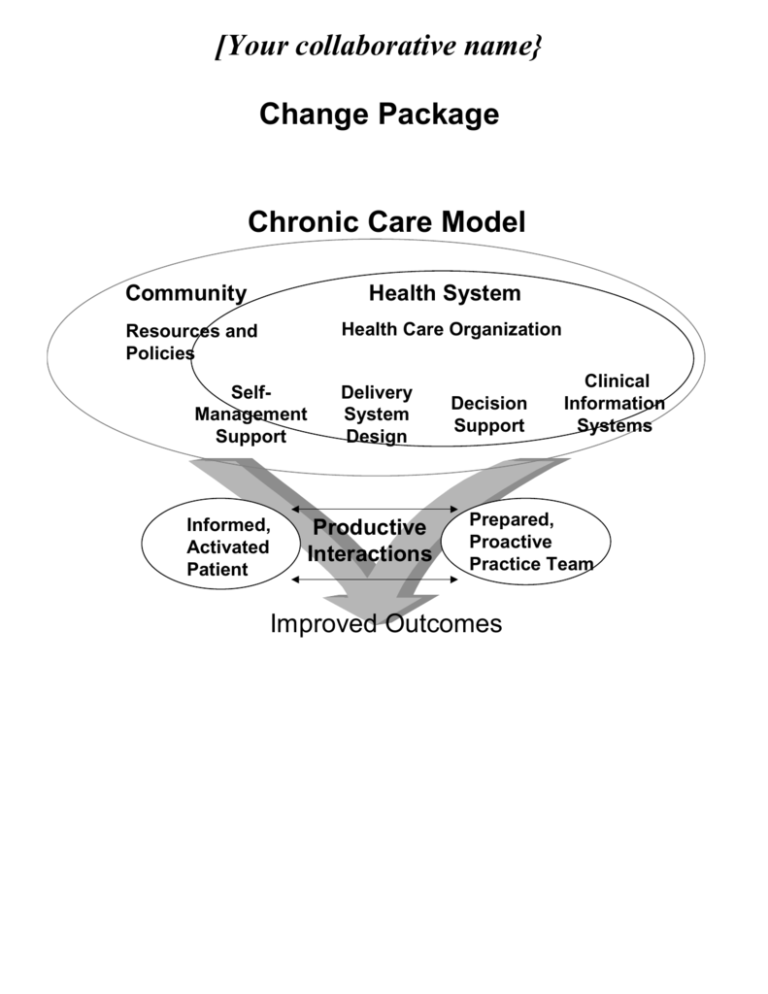
[Your collaborative name} Change Package Chronic Care Model Community Health System Health Care Organization Resources and Policies SelfManagement Support Informed, Activated Patient Delivery System Design Productive Interactions Decision Support Clinical Information Systems Prepared, Proactive Practice Team Improved Outcomes Summary of Chronic Care Model Effective outpatient chronic illness care is characterized by productive interactions between activated patients (as well as their family and caregivers) and a prepared practice team. This care takes place in a health care system that utilizes community resources. At the level of clinical practice, four areas (elements of the care model) influence the ability to deliver effective chronic illness care. These are self-management support, delivery system design, decision support and clinical information systems. The goal is to deliver care that is safe, effective, timely, patient-centered, efficient and equitable. System changes are checked against these criteria. The major objectives of each element of the Chronic Care Model are listed below. Each bulleted item is a principle for redesigning care. The table on page 3 is organized from conceptual to specific, left to right. Items in bold indicate high leverage changes (those that may have the most benefit). Italics indicate interrelationships between the different elements of the care model. Self-management support: Empower and prepare patients to manage their health and health care. Emphasize the patient’s central role in managing their health. Use effective self-management support strategies that include assessment, goal-setting, action planning, problem-solving and follow-up. Organize internal and community resources to provide ongoing self-management support to patients. Delivery system design: Assure the delivery of effective, efficient clinical care and self-management support. Define roles and distribute tasks among team members. Use planned interactions to support evidence-based care. Provide clinical case management services for complex patients. Ensure regular follow-up by the care team. Give care that patients understand and that fits with their cultural background. Decision support: Promote clinical care that is consistent with scientific evidence and patient preferences. Embed evidence-based guidelines into daily clinical practice. Integrate specialist expertise and primary care. Use proven provider education methods. Share evidence-based guidelines and information with patients to encourage their participation. Clinical information system: Organize patient and population data to facilitate efficient and effective care. Provide timely reminders for providers and patients. Identify relevant subpopulations for proactive care. Facilitate individual patient care planning. Share information with patients and providers to coordinate care. Monitor performance of practice team and care system. Health care organization: Create a culture, organization and mechanisms that promote safe, high quality care. Visibly support improvement at all levels of the organization, beginning with the senior leader. Promote effective improvement strategies aimed at comprehensive system change. Encourage open and systematic handling of errors and quality problems to improve care. Provide incentives based on quality of care. Develop agreements that facilitate care coordination within and across organizations. Community: Mobilize community resources to meet needs of patients. Encourage patients to participate in effective community programs. Form partnerships with community organizations to support and develop interventions that fill gaps in needed services. Advocate for policies to improve patient care . 2 11-13-03 version SELF-MANAGEMENT SUPPORT Empower and prepare patients to manage their health and health care. CHANGE CONCEPT Emphasize the patient’s central role in managing their health. KEY CHANGES EXAMPLES [Insert your own examples here. Caution: you should be prepared to provide examples of each tool or form you mention!] Describe the patient’s role in managing their At a health maintenance exam, state “Your health is in your hands. We would like to health at each encounter. help you achieve the best health possible.” At the moment of diagnosis, say, “X is a serious ongoing health problem. We are here to provide the best medical care for your condition, but you are the day-to-day manager of the condition.” Use effective selfmanagement support strategies that include goal setting, action planning and problem-solving and follow-up. Use the 5 A’s (ASSESS, ADVISE, AGREE, ASSIST, ARRANGE) to work with patients: (detail follows) ASSESS patient’s beliefs, behavior, and knowledge. ADVISE patients by providing specific information about health risks and benefits of change ASSESS: Use the Problem Areas in Diabetes scale. Use interviewing techniques from the Bayer Communication workshop to understand patient’s beliefs about their health. Ask patients what they know about X before providing information. Use BPHC manual assessment tools. Use tips from cultural competency training in assessments. Use assessment tools to determine who will be cared for by primary care team and who needs further assistance. ADVISE: Personalize all patient information and provide information when and how patients like to receive it Link exam or lab test findings to behaviors. Use run charts to present information. Sketch or diagram key concepts for health, functional status or pathophysiology to improve patient understanding. Use howsyourhealth.org to determine patient risk. Give patients print-outs of their laboratory results with explanations of what each test 3 11-13-03 version means. AGREE on collaboratively set goals based on patient’s confidence in their ability to change the behavior . ASSIST patients with problem-solving by identifying personal barriers, strategies, and social/environmental support ARRANGE a specific follow-up plan. Ask patients if they want more information about X and provide handouts or access to a web-based health database. AGREE Use peer mentors as health coaches. Develop personal action plans with patients following the format of “Living a Healthy Life with Chronic Conditions” (Lorig et al.) Assess patient confidence to achieve their action plan using a 1-10 scale. (Also described in Lorig et al.) Work with a community agency to sponsor “Chronic Disease Self-management programs” as described by Lorig et al. Use CARE vital signs from howsyourhealth.org to set goals Use techniques from motivational interviewing (express empathy, develop discrepancy, avoid argumentation, roll with resistance, support self-efficacy) ASSIST Have social workers learn problem-solving therapy and send patients who need further assistance to them. Use problem-solving method described by Lorig et al individually and in groups to teach patients problem solving skills. Hold a group diabetes visit and incorporate goal-setting, action-planning and problemsolving into the agenda. Identify community resources for support and refer patients (ex: Tobacco Quit Line, Health Clubs with a wide range of programs) Support efforts for safe walking programs, healthy food choices in schools, PE programs, etc. Refer patients to on-line sources of support. ARRANGE Schedule telephone follow-up and make it part of someone’s job description. Engage volunteers to assist with follow-up. Partner with community outreach programs to provide follow-up in homes and community settings. Use email to communicate with patients about goals, action plans and follow-up. 4 11-13-03 version Organize internal and external resources to provide ongoing selfmanagement support to patients. Use effective stand-alone programs Chronic Disease Self-Management Program (Kate Lorig, Stanford Patient Education Research Center) Open Airways for Asthma (American Lung Association) Arthritis Self-help Course, Arthritis Foundation Positive Self-Management Program, HIV: (Kate Lorig, Stanford Patient Education Research Center) Tomando Control de su Salud (Kate Lorig, Stanford Patient Education Research Center) Determine roles of the team to carry out self-management support before office visits, during office visits and between office visits. Try different staff members for different steps of the model. Train providers to deliver self-management support. Send providers to Bayer “Choices and Changes” training. Read “Health Behavior Change” by Rollnick. Go to a workshop by Rick Botelho. Have team share their training with each other. Learn motivational interviewing techniques. DELIVERY SYSTEM DESIGN Assure the delivery of effective, efficient clinical care and self-management support. CHANGE CONCEPT Define roles and distribute tasks among team members KEY CHANGES Define and develop the team as a unit. Determine process for care and assign team members to tasks. Match the work to the individual’s licensure and capability. Cross train staff. Use protocols and standing orders for care. (see decision support.) EXAMPLES [Insert your own examples here. Caution: you should be prepared to provide examples of each tool or form you mention!] Have receptionist obtain history, recent health info and VS, MD examines, RN does self-management and follow-up. Determine back-up staff for each task. Use protocols. Use clinical microsystem workbook to get to know team and work that needs to be done and adapt staffing appropriately. 5 11-13-03 version Use planned interactions to support evidence-based care. Use 1:1 visits to review current status, deliver evidence-based services, and optimize disease control. Use group visits to deliver care to interested patients. Predict needs of patients See clinical information system. Provide clinical case management services for complex patients Develop patient selection criteria and procedures for more complex patients. Determine availability of clinical case management services. Clinical Case Management Services include: Regularly assess disease control, success of care plan and self-management status Adjust therapy by protocol or communicate need to physician immediately Provide self-management support Provide intense follow-up Assist with negotiating the health care system. Invite patients with chronic health needs in for a planned visit. Compile a list of patient concerns, prioritize them with patient and address them in order. Use registry to proactively contact patients for follow-up. Pre-arrange telephone or e-mail follow-up at a face-to-face visit. Have office nurse interact with selected patients who have chronic heart failure to improve their self-management skills. Have nurses provide stepped care for patients with hypertension as part of team care. Inform patients of visit agenda at beginning of visit, check to see if that meets their expectations. (“You are here today for your arthritis. I am going to review your selfmanagement plan, assess your pain and function and then we will talk about next steps. Does that sound like what you were expecting today?”. . If clinical case management services are available, assure that complex patients receive these services. If clinical case management services are not available, review roles and tasks and distribute them amongst the team. (see above.) 6 11-13-03 version Ensure regular followup by the primary care team. Develop a process for follow-up Tailor follow up to patient and provider needs. Eliminate unnecessary follow-ups. Schedule follow-up. Monitor for missed follow-up. Proactively reach out for those who do not attend follow-ups. Give care that patients understand and that fits with their cultural background. Solicit patient and family preferences. Train staff in communication techniques with patients of different cultures. Review understanding with patients. DECISION SUPPORT Promote clinical care that is consistent with scientific evidence and patient preferences. CHANGE CONCEPT KEY CHANGES EXAMPLES [Insert your own examples here. Caution: you should be prepared to provide examples of each tool or form you mention!] Embed evidence-based guidelines into daily clinical practice. Use locally adapted evidence-based guidelines that include standardized severity assessment and intensification of care. Post guidelines on the back of flow sheets. Provide pocket cards with guidelines. Agree upon decision rules in EMR for most common diagnoses. Use a URI template with your EMR. Have patients complete severity or risk assessment tools prior to visit. Use standardized phone or e-mail follow-up protocols to identify patients needing stepped-up care. Use encounter forms which highlight needed services.. Integrate specialist expertise and primary care. Build prompts for guideline-driven care into daily routines. Use standing orders to assure delivery of evidence-based interventions and prevent errors. See Delivery System Design for concepts related to team roles. Create a mutually agreed-on care plan that is used in primary and specialty care. (See Develop and place template for standing orders for routine labs, diagnostic tests and immunizations on the chart for patients with diabetes. Develop standing orders for chemotherapy patients. Web-based shared care plan accessible throughout geographic region (Whatcom county pursuing perfection team.) 7 11-13-03 version clinical information system.) Engage specialists in process of primary care. Use proven provider education methods. Share evidence-based guidelines and information with patients to encourage their participation. Provide education using problem-based learning. Provide opportunities to learn system change methods (See organization of health care and clinical information system about measurement and quality improvement.) Encourage patients to ask for guideline-based care. Use proven shared decision-making tools in relevant clinical situations. Develop an organized approach to link patients to easily accessible, scientifically accurate information. Establish templates for specialist and primary care communication via email Establish a service agreement and protocol for specialist provision of decision support via priority pager. Establish service agreements and guidelines for referral to specialist care. Have designated specialist on-call for brief phone consults to primary care. At their request, have endocrinologist review notes of primary care for diabetes patients. Establish bimonthly case conferences using the common cases. Have specialist spend half day doing mini-clinics with primary care teams. Teach goal-setting skills at team meeting using role-playing. Use academic detailing to provide updates on clinical topics. Give patients a handout called “Expectations for Care” that reviews the prevention and ongoing care standards for them. Review a customized care pathway with patients as part of action planning. Use internet resource in discussion with patient about appropriate guidelines and evidence regarding their care. Use shared decision-making CD-ROMS for patients considering work up for prostate cancer. Develop decision balance tools for frequently encountered situations. Review all patient literature in the office for accuracy, consistency with guidelines and acceptability to patients. Purchase Healthwise handbooks for the practice nurses and patients. Subscribe to an on-line health database for patients. Review public domain websites and recommend one to patients. CLINICAL INFORMATION SYSTEM Organize patient and population data to facilitate efficient and effective care. CHANGE CONCEPT KEY CHANGES EXAMPLES [Insert your own examples here. Caution: you should be prepared to provide examples of each tool or form you mention!] 8 11-13-03 version Provide timely reminders for providers and patients. Identify relevant subpopulations for proactive care. Assure that database contains information to prompt guideline-based care at taime of service for providers and patients.. Start a spiral notebook or card file to capture critical clinical information. Use a public domain registry like CV-DEMS to capture information. Purchase a registry product (for example, http://www.docsite.com ) Adapt your EMR for registry useSort your spiral notebook with sheets sorted by follow-up date. Make prompts visible in care routines. (see Decision support for information about prompts.) Use patient flow sheet. Use DEMS care form with graphs of patient data. Define criteria for subpopulations. Review guideline and develop exception reports about key clinical topics, such as CHF patients without a recorded EF or not on optimal therapy, people with diabetes who don’t have a current foot exam or haven’t had a HbA1c in past year. Designate a staff member to routine review and arrange care for patients identified in subpopulations. Monthly review of patient exception reports for patients with diabetes who aren’t on an ACE inhibitor are called in for group visit to describe evidence for ACEI in patients with diabetes. Call patients in who are missing services from an exception report through registry or EMR. Give patients graphs of their clinical data from DEMS. Use a care plan template that includes clinical care and self-management issues. Facilitate individual patient care planning Provide historical information to patients in order to develop a care plan. Share information with patients and providers to coordinate care. Resolve technological and privacy issues in sharing data. Use a shared EMR across sites. Use mutually agreed on flow sheets faxed between sites. Patient held medical record and secure access to selected parts of medical records. Assure timely access to key clinical information at all points of care. Use an EMR that is accessible throughout the system. Have a confidential fax system to communicate with ER and home care. Develop a measurement system linked to QI goals. (See organization of health care for information about quality improvement.) Query registry to determine percent of diabetic patients that have not had a HbA1c in last 6 months. Report on a run chart and repeat each month. Review next 20 pts with a diagnosis or preventive need against standards. Monitor performance of practice team and care system. 9 11-13-03 version Provide timely unblended performance data with links to practice improvement. (See organization of health care for information about quality improvement.) Create a clinic data wall to display performance data. Begin a clinical initiative based on findings (diabetes care, immunization, pain management, anticipating side effects of chemotherapy). Create report for senior leaders. HEALTH CARE ORGANIZATION Create a culture, organization and mechanisms that promote safe, high quality care. CHANGE CONCEPT Visibly support improvement at all levels of the organization, beginning with the senior leader. KEY CHANGES The senior leader updates the board, staff and community on progress on a regular basis. EXAMPLES [Insert your own examples here. Caution: you should be prepared to provide examples of each tool or form you mention!] QI director attends monthly board meetings and provides one page progress summary. The senior leader incorporates quality into the business plan and mission statement. Promote effective improvement strategies aimed at comprehensive system change All employees of the organization regularly review quality of clinical care. Quality updates are provided in employee newsletter. Every staff member is on a QI team. The senior leader communicates the organization’s culture of quality to all staff. Support for quality improvement is a core budget priority. Senior leader mentions quality in every staff presentation. The organization builds improvement on a base of evidence. QI committee uses evidence to decide which topics to address. QI has separate budget. Every staff member given $300 to spend to improve care at the facility. 10 11-13-03 version The organization uses the chronic care model, the model for improvement and a learning model to continuously improve the system. The senior leader takes responsibility for spread of improvements. Encourage open and systematic handling of errors and quality problems to improve care. Provide incentives based on quality of care. Senior leader appoints spread team and creates a timeline for spread of change. The organization creates a process for active Revise orientation manuals to redesigned system. reporting of errors and quality problems. Use significant event analysis instead of blaming individuals for problems. The organization addresses errors and quality problems through system redesign. The senior leader ensures a valid and trusted set of performance indicators. The organization uses performance indicators to reward teams for reaching quality goals. Develop agreements that facilitate care coordination within and across organizations Senior leader participates in PDSA cycles. Organization has an internal collaborative. Organization adopts the chronic care model. Promote multidisciplinary teamwork in care of patients Establish cooperative relationships with other organizations, facilities, and providers. Event analysis is used to redesign system. Staff members participate in selection and definition of measures. Selected staff members double-check quality of their data and compare to system reports of data. 10% of salary is withheld and physician is rewarded at year’s end if personalized quality targets are met. Team with highest per cent of patients with mammograms receives a pizza party for a reward. Physician with biggest improvement in ave HbA1c for patient panel receives extra CME day. Use Microsystems workbook to review team roles and responsibilities. Operations director meets with ER to create agreement on sharing data for asthma patients. QI director meets with director of nursing of visiting nurse services to coordinate CHF care.. 11 11-13-03 version COMMUNITY Mobilize community resources to meet needs of patients. CHANGE CONCEPT Encourage patients to participate in effective community programs Form partnerships with community organizations to support and develop interventions that fill gaps in needed services. KEY CHANGES Identify gaps in clinic services and see if they are provided in the community. EXAMPLES [Insert your own examples here. Caution: you should be prepared to provide examples of each tool or form you mention!] Call Senior Information and Assistance to see how services are cataloged and create a way to link to that. Make a resource guide and provide it to patients. Create a “Needy Med” program notebook for patients and use to refill prescriptions. Evaluate the quality of potentially available services Link patients to community services that track outcomes. Visit community agencies and ask for their outcome data. Designate staff member to be “community resource expert.” Work with parish nurses and work-site health programs. In a huddle, discuss ways to link patients to community resources. Follow-up with patients receiving community services Establish a network to extend services into the community. Call patients after referral to a program to see if it was acceptable. Invite community programs to participate in care and redesign efforts. Raise community awareness through networking and education Engage the community to provide resources for needed services. Ask community members to serve on improvement team. Co-sponsor an effective exercise program with a local health club. Work with local health department to identify patients with health care needs Serve on the board of other community agencies. Obtain a grant from a local agency to provide monitoring equipment for patients. Arrange for health professions students to assist with populating the registry. Ask for unrestricted educational funds from pharmaceutical representatives. Arrange for staff members from specialist to deliver care in clinic setting. Have promotoras visit migrant camps. Work with churches on blood pressure monitoring. Work with beauty shops to promote health screening. 12 11-13-03 version Advocate for policies to improve patient care Identify priority areas for legislative and regulatory changes. Identify community partners to address legislative and regulatory issues. Work with an asthma coalition to increase Form or work with community groups to change legislation and resultation. Meet with employer groups and health plans to provide yearly diabetes education benefit. Work with health plans to provide reimbursement for group visits 13
